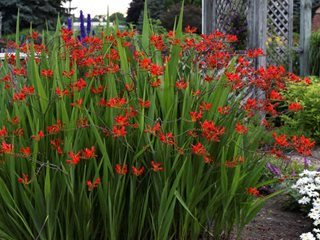How to Grow and Care for Crocosmia Flowers
A cousin of Gladiolus, this hardy summer-blooming bulb is easy to grow and brings tropical flair to northern gardens.One of the best ways to break your garden out of the summer doldrums is to plant colorful summer-blooming bulbs and tubers, such as gladioli and tuberous begonias. Typically planted in the spring, these warm-weather bloomers usually don’t survive cold winters if the bulbs are left in the ground. However, one notable exception is Crocosmia.
Despite its tropical origin, this vigorous perennial is hardy down to zone 5 and can stay in the ground year-round in all but the harshest climates, reliably blooming season after season. The lily-like flowers light up summer garden beds and borders and are especially irresistible to hummingbirds. Even when Crocosmia are not in bloom, their fountain-shaped clumps of spiky foliage offer contrasting form and vertical interest.
On this page: Basics | Planting Crocosmia | Crocosmia Care | Pictures | Design Ideas
On this page:
THE BASICS
Botanical name:
Crocosmia
Common names:
Montbretia, coppertips, falling stars
Plant type:
Herbaceous perennial, grown from clump-forming corms
Zones:
Perennial in zones 5-9. In colder climates, you may need to lift the crocosmia corms in the fall and store them indoors over winter. (See more on digging & storing bulbs.)
Height:
1½ to 4 feet, depending on the variety
Exposure:
Thrives in full sun, but also grows well in partial shade—although it may not flower as prolifically.
Bloom Time:
Mid to late summer
Crocosmia flowers:
Trumpet-shaped flowers in blazingly bright shades of red, orange, and yellow open in succession from the bottom up.
Crocosmia foliage:
Sword-shaped foliage similar to gladiolus.
Special attributes:
- Attracts hummingbirds and butterflies
- Deer and rabbit resistant
- Excellent for cutting
- Naturalizes readily
PLANTING CROCOSMIA
When to plant:
Plant crocosmia corms in spring, after the danger of frost has passed. They can be slow to sprout, especially if temperatures are cool. To jumpstart growth, wait until soil and air temperatures warm up.
How to plant:
In garden beds, plant crocosmia corms 2 to 3 inches deep and 8 to 10 inches apart, with the pointed end facing up. Mass the corms together in groups of 10 or more for the best effect.
Planting in containers:
If growing in containers, plant to the same depth in any well-drained good-quality potting mix in a pot with adequate drainage holes.
Soil:
Crocosmia grows best in moist, humus-rich, well-drained soil. Avoid planting in heavy clays or soggy sites.
Learn more about planting and caring for bulbs.
CROCOSMIA CARE
Watering:
Water as needed during the growing season to keep the soil evenly moist, giving your plants about an inch of water weekly.
Fertilizing:
Feed after initial planting or in early spring with a balanced slow-release fertilizer formulated for bulbs and tubers.
After blooming:
Once the flowers are spent, they will simply fall off, giving way to attractive seedpods that persist into fall. Leave the foliage in place so it can gather sunlight to nourish next year’s growth. When leaves die back in late fall, cut them back to an inch or two above ground level.
Dividing:
Crocosmia should be divided every 2 to 3 years to prevent overcrowding and to keep them vigorous. The plant develops cormlets along its roots, making it very easy to propagate. With a gentle twist, simply break apart the offsets you find attached to the base of the main corm and replant them. You can lift and divide congested clumps in fall or in the spring before new growth starts.
Winter protection:
Because they are more cold hardy than other summer-blooming bulbs, you can usually leave them in the ground over winter. Cover them with a layer of mulch to insulate them from severe cold snaps. However, if you live in Zone 4 or below, lift the corms, store them in a cool, dry location, and replant them in the spring.
Diseases and Pests:
Although impervious to most pests and diseases, crocosmias are particularly susceptible to spider mites. Avoid an infestation by hosing the leaves down with a strong spray of water once or twice a week. This will dislodge any mites and create an inhospitable environment.
CROCOSMIA PICTURES
USING CROCOSMIA IN YOUR GARDEN
- Use as a focal point in garden beds and borders
- Plant in mass for greater impact
- Design container arrangements using as a centerpiece, or "thriller"
- A perfect choice for pollinator gardens
- Add to a cut flower garden for mid and late-summer bouquets
- Crocosmia adds foliar interest to gardens with its slender, strap-shaped leaves
RELATED:
More Bulbs for Your Garden
20 Best Summer Bulbs to Grow
21 Easiest Flowers for Beginners
21 Low-Maintenance Plants








